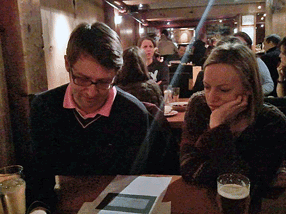Recently I published a little booklet called Hanging by a serif: a few words about designing with words. This is the culmination of a project I’ve been working on, off and on, for more than a year: pulling a selection of statements about typography and design from my own writing and presenting them, one to a page, along with a simple decorative element. The hook – quite literally, in some cases – is that those visual elements are all enlarged details of serifs, taken from a wide variety of typefaces. (You’d be surprised how much alike the serifs look on a lot of otherwise distinctive typefaces, when you blow them up in size and cut off the rest of the letter.) I had fun with this, as you might imagine. The hardest part was forcing myself to edit or rewrite my own words, to make them more appropriate to this format and purpose. It was also difficult choosing the quotes, and picking the serifs, but that was the kind of task that you can only revel in: a richness of choice.
One early recipient of a digital version, Scott-Martin Kosofsky, unexpectedly suggested that I “may have invented a new genre, design maxims, making you a kind of typographic Rochefoucauld.” I certainly doubt that my little booklet will go through as many editions and revisions as La Rochefoucauld’s Maximes, but I’ll be happy if it finds a use in the hands of its readers.
For an early draft, which I wanted to take with me on a visit to San Francisco to show to Jack Stauffacher and others at one of his weekly Friday lunches, I had trouble getting the booklet to print properly as page spreads, so I just printed the pages individually and bundled them into a wrap-around folded cover, just to suggest how it might all work as a booklet. What that inadvertant format showed me, however, was that these pages could also work singly, as individual cards. The actual content of those pages has undergone a good bit of revision since that San Francisco trip, but this is the reason why I’m offering Hanging by a serif both as a saddle-stitched booklet and as a set of cards.
When I showed a version of the cards to Juliet Shen at one of our local typographers’ pub gatherings, her immediate thought was, “I could give each of my students one of these and have them do a project based on it.” I hadn’t thought of that; perhaps they have a future use as a teaching tool. (You be the judge.)
This is the “first iteration” of Hanging by a serif; I’m sure it will evolve and appear draped in other clothes. Right now, you can buy the booklet or the cards from the newly created Shop page on this website, and they will undoubtedly be available through other sellers eventually. I sold a few at TypeCon in the SOTA store, and I expect I’ll have at least a few with me at next month’s ATypI conference in Amsterdam. Or you can use PayPal to buy a copy right here, and have me send it to you directly. (If you’re interested in a larger quantity, just send me e-mail at john <at> johndberry <dot> com and let me know.)


